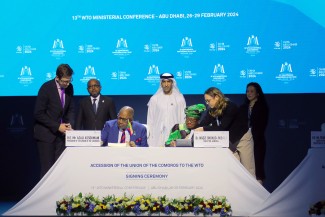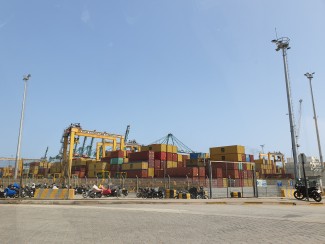Originally published by the Diplomat Tuesday, 24 May 2022
When it comes to cutting emissions, there is low-hanging fruit ripe for the picking. These Asia-Pacific countries show how to do it.
International trade and investment drive economic growth and remain critical for the least developed countries (LDCs) to attain the Sustainable Development Goals. However, growth has often come at a social and environmental cost.
Between 1990 and 2018, global greenhouse gas emissions (GHG) increased by nearly 50 percent. In the Asia‑Pacific region, they more than doubled. The Working Group III of the Intergovernmental Panel on Climate Change Sixth Assessment Report, released on April 4, 2022, confirms that limiting warming to around 1.5 degrees Celsius requires GHG emissions to be reduced by 43 percent by 2030.
Releasing the Report, the Working Group’s Co-Chair Jim Skea warned that without immediate and deep emissions reductions across all sectors, it would be impossible to meet the above target. In this context, it is an imperative that economies explore all possible avenues, including in policies governing trade and investment, to urgently reduce GHG emissions while maintaining trade competitiveness.
“Climate‑smart” trade and investment policies can reduce GHG emissions. They include fixing cross‑border trade inefficiencies; setting emissions standards for imports; and producing more efficiently, including through enhanced technology transfer.
Economic benefits can be magnified by making international trade transactions more cost‑effective through the digitalization of trade procedures. While the economic benefits associated with paperless trade facilitation are well known – over $600 billion in annual savings in international trade costs in the Asia-Pacific region alone – little attention has been paid to measuring the potential environmental benefits, particularly for the LDCs.
Research shows that, even with conservative assumptions, fully digitalizing a single end-to-end trade transaction is equivalent to the effect of planting 1.5 trees in terms of reducing emissions. In the Asia-Pacific region, this represents savings of about 13 million tons of carbon dioxide annually, equivalent to the carbon absorbed by 400 million trees. These efficiency gains come from handling data digitally, as opposed to direct savings on paper and ink.
There are also benefits to digitalizing transport networks. According to the United Nations Economic and Social Commission for Asia and the Pacific (UNESCAP), solutions include route optimization; remote monitoring of transport operations and network traffic management (to avoid congestion); simplified transport procedures (to reduce waiting time and delays); and electronic platforms enabling greater collaboration among freight operators, including facilitating modal shifts for more resilient freight movement.
Vanuatu has emerged as a trailblazer in the Asia‑Pacific region in leveraging the benefits of trade facilitation through the United Nations Conference on Trade and Development (UNCTAD)’s Automated System for Customs Data (ASYCUDA) program. For over 40 years, ASYCUDA, which is UNCTAD’s largest technical assistance program, has helped customs offices around the world clear goods faster and increase the pace of trade. Vanuatu is one of only seven ASYCUDA countries worldwide, and the only one in the Pacific region, running a single-window system using ASYCUDA.
Support from the Enhanced Integrated Framework has been instrumental in installing the Electronic Single Window, which is co-funded by the Governments of Vanuatu and Australia. It has reduced carbon dioxide emissions by 5,827 kg by eliminating or reducing paperwork in the sanitary and phytosanitary (SPS) certificate application and cargo clearance processes.
Trade information portals have also been found to be a tool for reducing energy consumption while increasing transparency and easing access to key information for traders. Paperwork in the SPS certification application process is down by 95 percent and has been eliminated in cargo clearing. The physical trips required to comply with these two processes are down by 86 percent and 100 percent, respectively, resulting in Vanuatu becoming the number one Asia-Pacific Small Island Developing State in digital and sustainable trade in 2021, based on a UNESCAP survey.
The country’s approach aligns sustainable economic growth and development through low-impact industries and modern technologies with a long-term vision, as outlined in the environmental pillar of Vanuatu’s National Sustainable Development Plan.
Similarly, Timor-Leste has, since the implementation of ASYCUDA World, automated several procedures, including electronic manifest submission, thereby reducing paperwork. In 2020, some 1,324 manifests were submitted electronically, saving 198,000 pages.
With these insights, the LDCs can make their trade as well as investments climate‑smart through a few potential interventions, building on a joint report by UNESCAP, the U.N. Environment Program, and UNCTAD. Although the report focuses on the Asia-Pacific region, it is applicable to many LDCs if not all.
First, support systems such as ASYCUDA can be extremely useful, by making processes more efficient and reducing emissions from printing, waiting, and unnecessary procedures in trade, including physical trips to offices. Vanuatu has presented an effective example of how an LDC together with partners can take the lead in this process.
Second, facilitating international trade and transport will lead to more goods being traded and additional emissions from their transportation. However, by concurrently improving the efficiency of transport operations, emissions can be significantly reduced. Transport and shipping companies can and should deploy these efficient technologies and make use of alternatively fueled vessels at scale.
Third, allocating resources more efficiently, including by locating production where renewable energy is cheapest, can cut global emissions. This is an additional incentive for the LDCs to explore renewable energy solutions and develop incentives to attract the large-scale investments required in low‑carbon infrastructure. Cambodia has taken a lead in this area by redefining incentives for investment in green energy as well as investment in technology that contributes to climate change adaptation and mitigation.
The COVID-19 pandemic has spotlighted the need for trade and transport facilitation and increased digitalization. The added urgency of the climate threat and supply chain disruptions presents an opportunity for the LDCs to pursue sustainable and economically smart trade for increased prosperity.
If you would like to reuse any material published here, please let us know by sending an email to EIF Communications: eifcommunications@wto.org.



